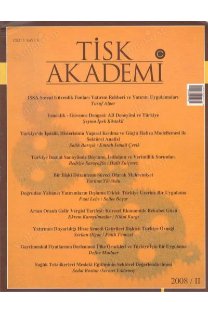Sabit Yatırım Harcamalarının Öncü Göstergeler Yöntemiyle Tahmini: Türkiye Örneği
Bu Çalışmada, Tükiye’deki sabit yatırım harcamalarının devresel yapısının incelenmesi ve öncü göstergeler yöntemi kullanılarak dönüş noktalarının tahmin edilmesi amaçlanmaktadır. Yatırım harcamalarının ve seçilen öncü göstergelerin devresel hareketlerinin belirlenmesinde büyüme devreleri yaklaşımı kullanılmıştır. İncelenen serilerin eğilim bileşenlerinden arındırılmasında Hodrick-Prescott eğilimden arındırma filtresi kullanılmıştır. Seçilen öncü göstergelerin devresel hareketleri ve dönüş noktaları belirlendikten sonra seriler temel bileşenler yöntemi kullanılarak endeks haline getirilmiştir. Oluşturulan endeksin sabit yatırım harcamalarının dönüş noktalarını tahmin etmedeki başarısını belirleyebilmek amacıyla probit modeli oluşturulmuş ve modelden alınan kestirimlerin başarısı incelenmiştir. Çalışmanın sonuçları, oluşturulan endeksin sabit yatırım harcamalarını başarılı bir şekilde tahmin ettiğini göstermektedir.
Anahtar Kelimeler:
yatırım
Analysis of Cyclical Behaviour of Fixed Investment for the Turkish Economy
This paper aims to analyse the cyclical behaviour of fixed investments in Turkey and then construct a composite leading indicators index to forecast the turning points of investment. The cycles of investment and selected leading indicators are identified following the growth cycle approach. The series are detrended using the Hodrick-Prescott detrending filter. After identification of the cycles and turning points of the selected leading indicators, they are combined into a single composite index. Then a probit model is estimated to evaluate the forecast performance of the composite index. The results show that the constructed CLI is considered to be helpful in monitoring and predicting investment expenditures. JEL
Keywords:
investment,
___
- Afonso, A. ve D. Furceri (2007), “Sectoral Business Cycle Synchronization in the European Union”, ISEG-UTL Economics Working Paper No. 02/2007/DE/UECE.
- Artis, M.J., R.C. Bladen-Hovell ve W. Zhang (1995), “Turning Points in the International Business Cycle: An Ex-post Analysis of the OECD Leading Indicators Series for the G-7 Countries”, OECD Economic Studies 24(2): 125-165.
- Barnes, S. ve C. Ellis (2005), “Indicators of Short-term Movements in Business Investment”, Bank of England Quarterly Bulletin, Spring 2005.
- Baxter, M. ve R. King (1999), “Measuring Business Cycles: Approximate Band-Pass Filters for Economic Time Series”, Review of Economics and Statistics, 81(4): 575-593.
- Canova F. (1999), “Does Detrending Matter for the Determination of the Reference Cycle and the Selection of Turning Points?”, The Economic Journal, 109(452): 126-150.
- Christiano, L. ve T. Fitzgerald (2003), “The Band Pass Filter”, International Economic Review, 4(2): 435-465.
- Cross, P. (2005), “Long-run Cycles in Business Investment”, Canadian Economic Observer, 11(010).
- Francois, P. ve H. Lloyd—Ellis (2004), “Investment Cycles” EconWPA Macroeconomics, (0405005).
- Hodrick, R. ve E. Prescott (1980), “Postwar U.S. Business Cycles: An Empirical Investigation”, Discussion Papers 451, Carnegie Mellon University.
- Imai, H. (1994), “China’s Endogenous Investment Cycle”, Journal of Comparative Economics, (19): 188-216.
- Krystalogianni, A.; G. Matysiak ve S. Tsolacos (2004), “Forecasting UK Commercial Real Estate Cycle Phases with Leading Indicators: A Probit Approach”, Applied Economics, (36): 2347-2356.
- Mallikamas, R. P.; Y. Thaicharoen and Y. D. Rodpengsangkaha (2003), “Investment Cycles, Economic Recovery and Monetary Policy”, Bank of Thailand Discussion Paper. Nilsson, R. (2000), “OECD System of Leading Indicators”, Workshop on Key Economic Indicators, Bangkok.
- OECD (1987), “OECD Leading Indicators and Business Cycles in Member Countries 1960-1985”, OECD publication.
- Şahinöz, S. ve E. Erdoğan Çoşar (2008), “Characterising the Sectoral Growth Cycles in Turkish Manufacturing Industry”, unpublished manuscript.
- Zarnowitz, V. (1999), “Theory and History Behind Business Cycles: Are the 1990s the Onset of a Golden Age?”, Journal of Economic Perspectives, 10(2).
- Zarnowitz, V. ve A. Özyıldırım (2001), “Time Series Decomposition and Measurement of Business Cycles, Trends and Growth Cycles”, 26th CIRET Conference, Taiwan.
- Wen, Y. (1998), “Investment Cycles”, Journal of Economic Dynamics and Control, Vol. 22.
- ISSN: 1306-6757
- Yayın Aralığı: Yılda 2 Sayı
- Başlangıç: 2006
- Yayıncı: Türkiye Isveren Sendikalari Konfederasyonu
Sayıdaki Diğer Makaleler
Üçüncü Kişinin Uğradığı Kazada İşveren Kusurunun (Taksirinin) Kapsamı
Uluslararsı Göç ve Kalkınma Tartışmalarında Yeni Yaklaşımlar ve Türkiye
Avrupa Birliği Müktesebatı Işığında Alman Hukukunda Toplu İşçi Çıkarımına İlişkin Yasal Çerçeve
Beşeri Sermayenin Türkiye'de Bölgeler Arası Ekonomik Gelişme Açısından Önemi
Selahattin BEKMEZ, AYLİN ÇİĞDEM KÖNE, Derya GÜNAL
Psikolojik Taciz Davranışının Kamu Kurumları Arasında Karşılaştırılması Üzerine Bir Araştırma
Sabit Yatırım Harcamalarının Öncü Göstergeler Yöntemiyle Tahmini: Türkiye Örneği
Liderlik Tarzları ile Örgüt Kültürü Türleri Arasındaki İlişkiler: Bir Alan Çalışması
